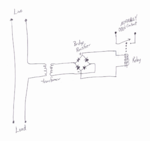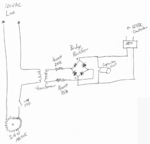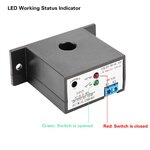Wdnbob
Newbie level 4
I have been digging through various forums and internet articles searching for a current sensing relay circuit that will activate a low voltage relay when the circuit senses a 120v machine drawing 5 or more amps of power.
I have hand drawn a schematic and is attached. My desire is to activate a low voltage circuit by simply "closing" the normally open contact of a relay. The article where I got the idea for this schematic calls for a 25amp solid state relay which, in my case, is serious overkill. I only need a very low voltage (12v to 24v) normally open contact closed connection that is most likely be a small milliampere load.
Having explained that, I begun thinking that a opt-coupler type device may be sufficient? Essentially I not sure what to replace the large (size and current) solid state relay with?
In simplest terms the circuit will work like this . . . my (woodworking) circular miter saw starts, the circuit senses my circular saw drawing current and "closes" a normally open relay that will control (start) my dust collector. When finished cutting (release the saw trigger, stopping saw), the circuit sense the lack of current draw and open the contacts to stop the dust collector.
Clearly, I do not have an electronics degree so any help would be greatly appreciated.
I have hand drawn a schematic and is attached. My desire is to activate a low voltage circuit by simply "closing" the normally open contact of a relay. The article where I got the idea for this schematic calls for a 25amp solid state relay which, in my case, is serious overkill. I only need a very low voltage (12v to 24v) normally open contact closed connection that is most likely be a small milliampere load.
Having explained that, I begun thinking that a opt-coupler type device may be sufficient? Essentially I not sure what to replace the large (size and current) solid state relay with?
In simplest terms the circuit will work like this . . . my (woodworking) circular miter saw starts, the circuit senses my circular saw drawing current and "closes" a normally open relay that will control (start) my dust collector. When finished cutting (release the saw trigger, stopping saw), the circuit sense the lack of current draw and open the contacts to stop the dust collector.
Clearly, I do not have an electronics degree so any help would be greatly appreciated.


